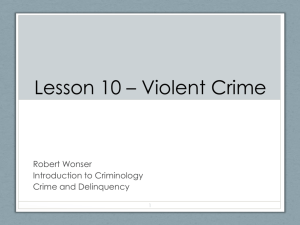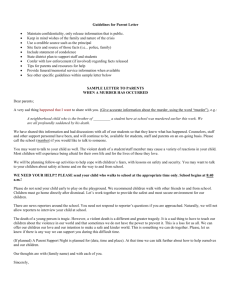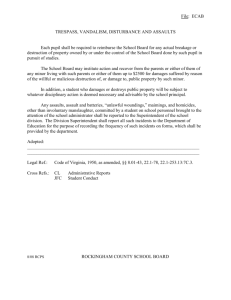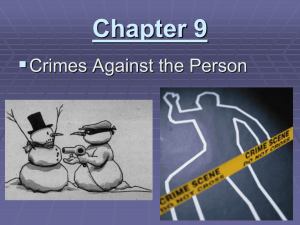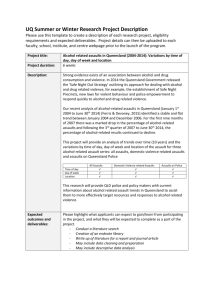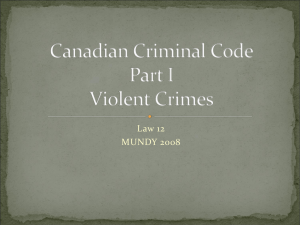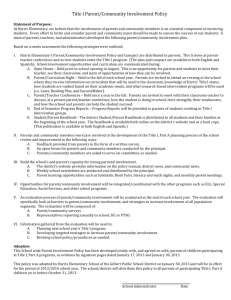Murder and Medicine - Psychology 242, Research Methods in
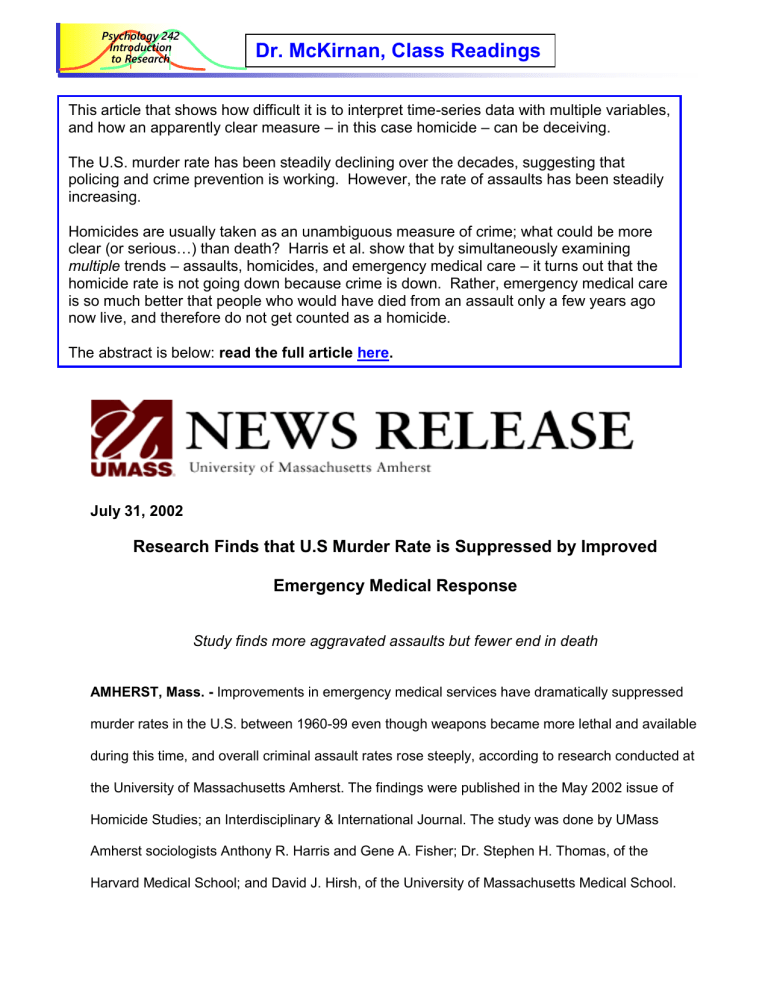
Psychology 242
Introduction to Research
Dr. McKirnan, Class Readings
This article that shows how difficult it is to interpret time-series data with multiple variables, and how an apparently clear measure
– in this case homicide – can be deceiving.
The U.S. murder rate has been steadily declining over the decades, suggesting that policing and crime prevention is working. However, the rate of assaults has been steadily increasing.
Homicides are usually taken as an unambiguous measure of crime; what could be more clear (or serious…) than death? Harris et al. show that by simultaneously examining multiple trends – assaults, homicides, and emergency medical care – it turns out that the homicide rate is not going down because crime is down. Rather, emergency medical care is so much better that people who would have died from an assault only a few years ago now live, and therefore do not get counted as a homicide.
The abstract is below: read the full article here .
July 31, 2002
Research Finds that U.S Murder Rate is Suppressed by Improved
Emergency Medical Response
Study finds more aggravated assaults but fewer end in death
AMHERST, Mass. Improvements in emergency medical services have dramatically suppressed murder rates in the U.S. between 1960-99 even though weapons became more lethal and available during this time, and overall criminal assault rates rose steeply, according to research conducted at the University of Massachusetts Amherst. The findings were published in the May 2002 issue of
Homicide Studies; an Interdisciplinary & International Journal. The study was done by UMass
Amherst sociologists Anthony R. Harris and Gene A. Fisher; Dr. Stephen H. Thomas, of the
Harvard Medical School; and David J. Hirsh, of the University of Massachusetts Medical School.
McKirnan, Psychology 242 readings, Murder and Medicine . p. 2
"The level of violence from assaults in America has risen dramatically over the past 40 to 50 years at the same time that guns have become more lethal and available," Harris says. "But because of the vast improvements in the nation’s access to and quality of emergency medical care – particularly since the Vietnam War – the outcome of these assaults is far less likely to be lethal."
"People who would have ended up in morgues 20 years ago, are now simply treated and released by a hospital, often in a matter of a few days," Harris says. "And people who would have faced the death penalty 20 years ago are now simply guilty of felonious assault, treated and released by prisons, often in a matter of a few years."
The research finds that overall lethality from criminal assault went down almost 70 percent from
1960-99, with annual declines of between 2.5 percent and 3 percent for firearm and knife assaults, and 3.5 percent and 4 percent a year for bodily and other assaults (such as poisoning or arson).
The primary reason for the dropping lethality rate is a set of medical variables, the study says, including the development of 911 services, the rapid stabilization and transport of trauma victims by skilled EMTs, the nationwide proliferation of hospitals into non-urban areas, the development of specialized trauma centers, and county-wide membership within coordinated regional trauma systems.
"Against a baseline of 1960, we estimate that without this technology, the U.S. would presently be experiencing 45,000 to 70,000 homicides a year instead of an actual 15,000 to 20,000," say the researchers in the report.
The research has implications for matters of national policy, Harris says. For example, when we study the impact of gun control legislation, the research suggests that what we really need to look at is how such legislation affects levels of gun violence, not simply changes in homicide rates. For another example, in debating the use of the death
D:\726893386.doc
McKirnan, Psychology 242 readings, Murder and Medicine . p. 3 penalty in general, or perhaps even with respect to a particular case, the research suggests one should consider the availability and quality of emergency medical care – or its absence – as a critical factor in determining whether murder has occurred, he says.
Harris and the other researchers used data from several sources, including the FBI’s national
Uniform Crime Report (UCR) which contains statistics dating from 1931. The data shows that in
1931, the murder rate was 8.2 per 100,000 people, but in 1998, that rate was 6.3 per 100,000 people, a drop of 25 percent. By comparison, the UCR data shows that the rate of aggravated assault was 700 percent higher than it was in 1931.
Among the questions raised by the study, Harris says, is whether researchers should pay more attention to the rate of aggravated assaults rather than murder rates when analyzing rates of violent crimes. But, the study warns, "The ominous rise of semi-automatic weapon use in assaults in the last 20 years may signal an ever-decreasing opportunity to make and to observe additional inroads in the transformation of homicide into assault. At some point in contesting the outcome of criminal assault to the body, weaponry may yet trump medicine."
-30-
Anthony Harris can be reached at aharris.javanet@rcn.com
or 413/296-8070.
Read the full article here .
Harris, A.R., Fisher, G.A., Thomas, S.H., & Hirsh, D.J. (2002). Murder and Medicine: The Lethality of Criminal Assault, 1960-1999. Homicide Studies; an Interdisciplinary & International Journal.
May, 2002.
D:\726893386.doc


